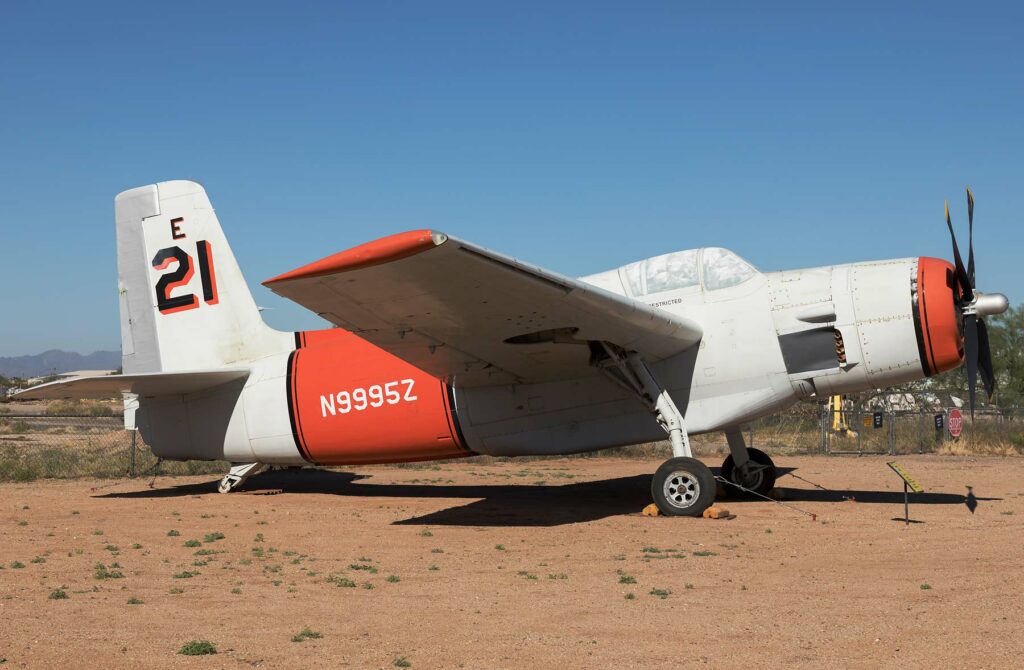The Grumman AF Guardian was the first purpose-built anti-submarine warfare (ASW) aircraft for the US Navy, deployed in the 1950s.
In brief
The Grumman AF Guardian, operational in the 1950s, was the United States Navy’s first aircraft designed exclusively for anti-submarine warfare (ASW). Developed in the wake of World War II, it represented a shift in naval aviation, addressing the growing threat of submarines in the Cold War context. The Guardian was a unique aircraft, functioning as a part of a hunter-killer team, with separate variants for detection (AF-2W) and attack (AF-2S). It featured a piston engine and a large radome, indicative of its ASW role. Despite its innovative design, the AF Guardian was quickly overshadowed by more advanced technology and was phased out after a relatively short service life, replaced by more capable aircraft like the S-2 Tracker.
The Grumman AF Guardian holds a distinctive place in aviation history as the first dedicated ASW aircraft of the US Navy.
History of the Development of the Grumman AF Guardian
In the years following World War II, the US Navy faced an evolving strategic landscape, marked by the emerging threat of Soviet submarines in the context of the Cold War. This threat necessitated a specialized aircraft capable of effective anti-submarine warfare. The Grumman Aircraft Engineering Corporation, known for its successful naval aircraft designs, was tasked with developing such an aircraft.
The development program for the AF Guardian was launched by Grumman in the late 1940s. The primary objective was to create an aircraft capable of locating and destroying submarines, a mission that became increasingly vital as submarine technology advanced. The design challenge was substantial, requiring integration of new technologies like airborne radar and magnetic anomaly detection.
The Grumman AF Guardian first flew on December 19, 1950. It did not receive a specific NATO nickname, as was common with many aircraft of the era.
Design of the Grumman AF Guardian
The design of the AF Guardian was unique, particularly in its operational concept. Instead of a single aircraft performing all ASW tasks, the Guardian was designed as two variants working in tandem: the AF-2W “hunter” and the AF-2S “killer.”
The AF-2W was equipped with a large, ventral radome housing the APS-20 radar, essential for detecting submarines. It had a length of 43 feet 4 inches (13.2 meters) and a wingspan of 60 feet 8 inches (18.5 meters). The AF-2S, lacking the radome, carried weapons such as torpedoes and depth charges and featured a retractable magnetic anomaly detector (MAD) boom.
Both variants were powered by a Pratt & Whitney R-2800 Double Wasp radial engine, producing 2,400 horsepower. This engine was reliable but represented older technology at a time when turboprop and jet engines were becoming prevalent.
The Guardian’s design reflected a transitional phase in ASW technology. Its approach of using two different aircraft for detection and attack was innovative but also highlighted the limitations of the technology of the time. The aircraft’s size and weight limited its onboard equipment and armament capacity.

Performance of the Grumman AF Guardian
The Grumman AF Guardian’s performance was adequate for its designed role during its service period. The R-2800 engine provided a top speed of approximately 250 knots (288 mph, 463 km/h), which was reasonable for ASW operations of the time. The aircraft had a service ceiling of 15,000 feet (4,570 meters) and a range of about 1,300 nautical miles (1,497 miles, 2,408 kilometers).
When compared to its contemporaries, the Guardian was somewhat limited in speed and maneuverability. However, its specialized equipment for ASW, particularly in the AF-2W variant, was advanced for its time.
Variants of the Grumman AF Guardian
The two primary variants of the Guardian were the AF-2W and the AF-2S. The AF-2W, known as the “hunter,” was equipped with radar for submarine detection. The AF-2S, the “killer,” carried weapons for engaging submarines. This split function was a distinctive feature of the Guardian program. There were also a small number of trainer versions produced, designated as AF-3S, which were modified AF-2S airframes for training purposes.
Military Use and Combat of the Grumman AF Guardian
The Grumman AF Guardian was primarily used by the US Navy for ASW patrols during the 1950s. It was not involved in any major conflicts or battles, as its role was predominantly defensive, focused on countering submarine threats during the Cold War.
The Guardian’s armament included depth charges, bombs, and torpedoes, carried by the AF-2S variant. Its operations typically involved the AF-2W detecting a submarine with its radar, then directing the AF-2S to attack.
The Guardian was not exported to other countries, and its service life was relatively short. It was retired in the late 1950s, replaced by the more capable Grumman S-2 Tracker, which combined the hunter and killer roles into a single airframe with more advanced technology.
The Grumman AF Guardian was a pioneering aircraft in the field of ASW, addressing a specific Cold War-era military need with an innovative yet transitional approach. While it was soon eclipsed by more advanced designs, the Guardian’s development and service provided valuable lessons in specialized military aircraft design and the evolving requirements of naval aviation.
Back to the Special Aircraft section.